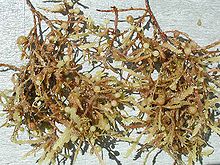- Neritic zone
-
Marine habitats 
Sargassum seaweed drifting in the neritic zone provides food and shelter for small epipelagic fish
Littoral zone Intertidal zone Estuaries Kelp forests Coral reefs Ocean banks Continental shelf Neritic zone Straits Pelagic zone Oceanic zone Seamounts Hydrothermal vents Cold seeps Demersal zone Benthic zone The neritic zone, also called coastal waters, the coastal ocean or the sublittoral zone,[1] is the part of the ocean extending from the low tide mark to the edge of the continental shelf, with a relatively shallow depth extending to about 200 meters (100 fathoms or 665 feet). The neritic zone has generally well-oxygenated water, low water pressure, and relatively stable temperature and salinity levels. These, combined with presence of light and the resulting photosynthetic life, such as phytoplankton and floating sargassum[2], make the neritic zone the location of the majority of sea life.
Zooplankton, free-floating creatures ranging from microscopic foraminiferans to small fish and shrimp, live in this zone, and together with the phytoplankton form the base of the food pyramid that supports most of the world's great fishing areas.
At the edge of the neritic zone the continental shelves end, rapidly descending to the deeper oceanic crust and the pelagic zone.
See also
References
Categories:- Aquatic ecology
- Fisheries
- Physical oceanography
- Aquatic biomes
Wikimedia Foundation. 2010.
